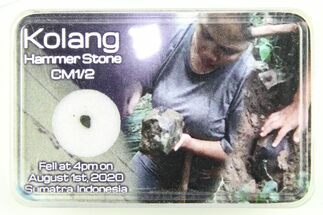.16" Kolang Chondrite Meteorite - 2020 Witnessed Fall
This is quite the astronomical specimen: a .16" wide fragment of the Kolang meteorite, a witnessed fall that landed in the town of Kolang, Indonesia on August 1, 2020 and crashed through a resident's home!
What Is A Hammer Stone?
Hammer stones are the names given to meteorite fragments that hit man-made objects, animals, or people when they fall. Hammer stones are often identified by the scuffed fusion crusts that can contain traces of paint, rubble, or other materials from the objects they hit. Because they are so rare, they are valued collectors' items. Often the items hammer stones hit go up in value, just be being damaged by a meteorite!
Hammer stones are the names given to meteorite fragments that hit man-made objects, animals, or people when they fall. Hammer stones are often identified by the scuffed fusion crusts that can contain traces of paint, rubble, or other materials from the objects they hit. Because they are so rare, they are valued collectors' items. Often the items hammer stones hit go up in value, just be being damaged by a meteorite!
Kolang is the name given to the CM1/2 carbonaceous chondrite that fell in Indonesia on August 1st, 2020.
Around 4:00 PM local time, loud booms shook houses in the Central Tapanuli Regency in northwestern Sumatra. A roughy 2-kilogram stone punched a hole in through the roof of a house in the town of Kolang, embedding itself in the ground nearby. This, a second large stone that fell in a nearby rice paddy, and two others were recovered, totaling about 2.5 kilograms in mass. The two larger stones have documented ownership, but the whereabouts of the two smaller stones are unknown.
The main 2-kilogram mass is rather blocky, but displays prominent regmaglypts across its surface. The interior is generally quite brecciated: according to the Meteoritical Bulletin, fragments crushed in water emit a "delicate, earthy smell" that can also be found in other carbonaceous chondrites. The interior contains lighter brecciated clasts and chondrules suspended in a dark gray matrix, with occasional calcium-aluminum inclusions (CAIs) and coarse-grained sulfides.
Around 4:00 PM local time, loud booms shook houses in the Central Tapanuli Regency in northwestern Sumatra. A roughy 2-kilogram stone punched a hole in through the roof of a house in the town of Kolang, embedding itself in the ground nearby. This, a second large stone that fell in a nearby rice paddy, and two others were recovered, totaling about 2.5 kilograms in mass. The two larger stones have documented ownership, but the whereabouts of the two smaller stones are unknown.
The main 2-kilogram mass is rather blocky, but displays prominent regmaglypts across its surface. The interior is generally quite brecciated: according to the Meteoritical Bulletin, fragments crushed in water emit a "delicate, earthy smell" that can also be found in other carbonaceous chondrites. The interior contains lighter brecciated clasts and chondrules suspended in a dark gray matrix, with occasional calcium-aluminum inclusions (CAIs) and coarse-grained sulfides.
About Chondrites
Chondrites are stony (non-metallic) meteorites that have not been modified by either melting or differentiation of the parent body. They are formed when various types of dust and small grains in the early Solar System accreted to form primitive asteroids. Some such bodies are captured in the planet’s gravity well and pulled to the surface. They are by far the most common type of meteorite, representing about 86 percent of all meteorites that have fallen to Earth.
Prominent among the components present in chondrites are the enigmatic chondrules, millimeter-sized spherical objects that originated as freely floating, molten or partially molten droplets in space; most chondrules are rich in the silicate minerals olivine and pyroxene. Chondrites also contain particles of various metals such as nickel, iron, and aluminum. These formed at the very beginning of the solar system and aggregated over time: they are the oldest rocks known on Earth!
Chondrites are divided into about fifteen distinct groups on the basis of their mineralogy, bulk chemical composition, and oxygen isotope compositions. The various chondrite groups likely originated on separate asteroids or groups of related asteroids. Each chondrite group has a distinctive mixture of chondrules, refractory inclusions, matrix (dust), characteristic chondrule sizes, and other components. Other ways of classifying chondrites include weathering and shock. The L chondrite group is the most common of these.
Chondrites are stony (non-metallic) meteorites that have not been modified by either melting or differentiation of the parent body. They are formed when various types of dust and small grains in the early Solar System accreted to form primitive asteroids. Some such bodies are captured in the planet’s gravity well and pulled to the surface. They are by far the most common type of meteorite, representing about 86 percent of all meteorites that have fallen to Earth.
Prominent among the components present in chondrites are the enigmatic chondrules, millimeter-sized spherical objects that originated as freely floating, molten or partially molten droplets in space; most chondrules are rich in the silicate minerals olivine and pyroxene. Chondrites also contain particles of various metals such as nickel, iron, and aluminum. These formed at the very beginning of the solar system and aggregated over time: they are the oldest rocks known on Earth!
Chondrites are divided into about fifteen distinct groups on the basis of their mineralogy, bulk chemical composition, and oxygen isotope compositions. The various chondrite groups likely originated on separate asteroids or groups of related asteroids. Each chondrite group has a distinctive mixture of chondrules, refractory inclusions, matrix (dust), characteristic chondrule sizes, and other components. Other ways of classifying chondrites include weathering and shock. The L chondrite group is the most common of these.
$99
TYPE
Carbonaceous Chondrite (CM1/2)
LOCATION
Kolang, Central Tapanuli Regency, North Sumatra, Indonesia
SIZE
.16" wide
CATEGORY
ITEM
#285719
 Reviews
Reviews









